Technology in Audit Engagements
VerifiedAdded on 2022/10/01
|10
|2241
|145
AI Summary
This document discusses the impact of technology in audit engagements and how it is changing the way auditors operate. It covers three key technologies that are affecting the audit profession: Machine Learning, Natural Language Processing, and Deep Learning. The document also provides rationales for the selected technologies and how they are assisting auditors in performing complex tasks like viral object recognition and others. The document concludes that while these technologies can reduce the extent of involvement of the auditors, they cannot replace the auditors wholly.
Contribute Materials
Your contribution can guide someone’s learning journey. Share your
documents today.
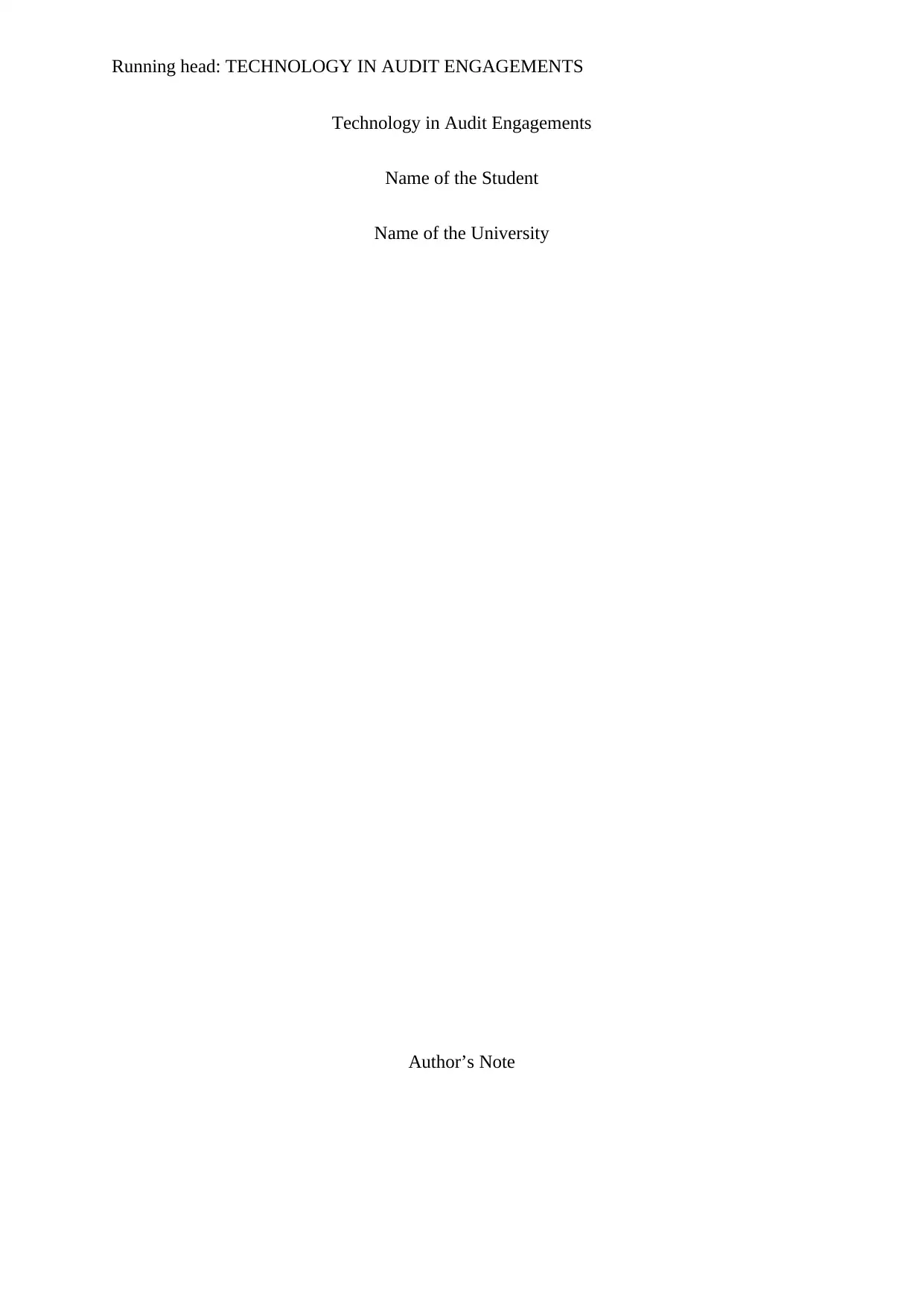
Running head: TECHNOLOGY IN AUDIT ENGAGEMENTS
Technology in Audit Engagements
Name of the Student
Name of the University
Author’s Note
Technology in Audit Engagements
Name of the Student
Name of the University
Author’s Note
Secure Best Marks with AI Grader
Need help grading? Try our AI Grader for instant feedback on your assignments.
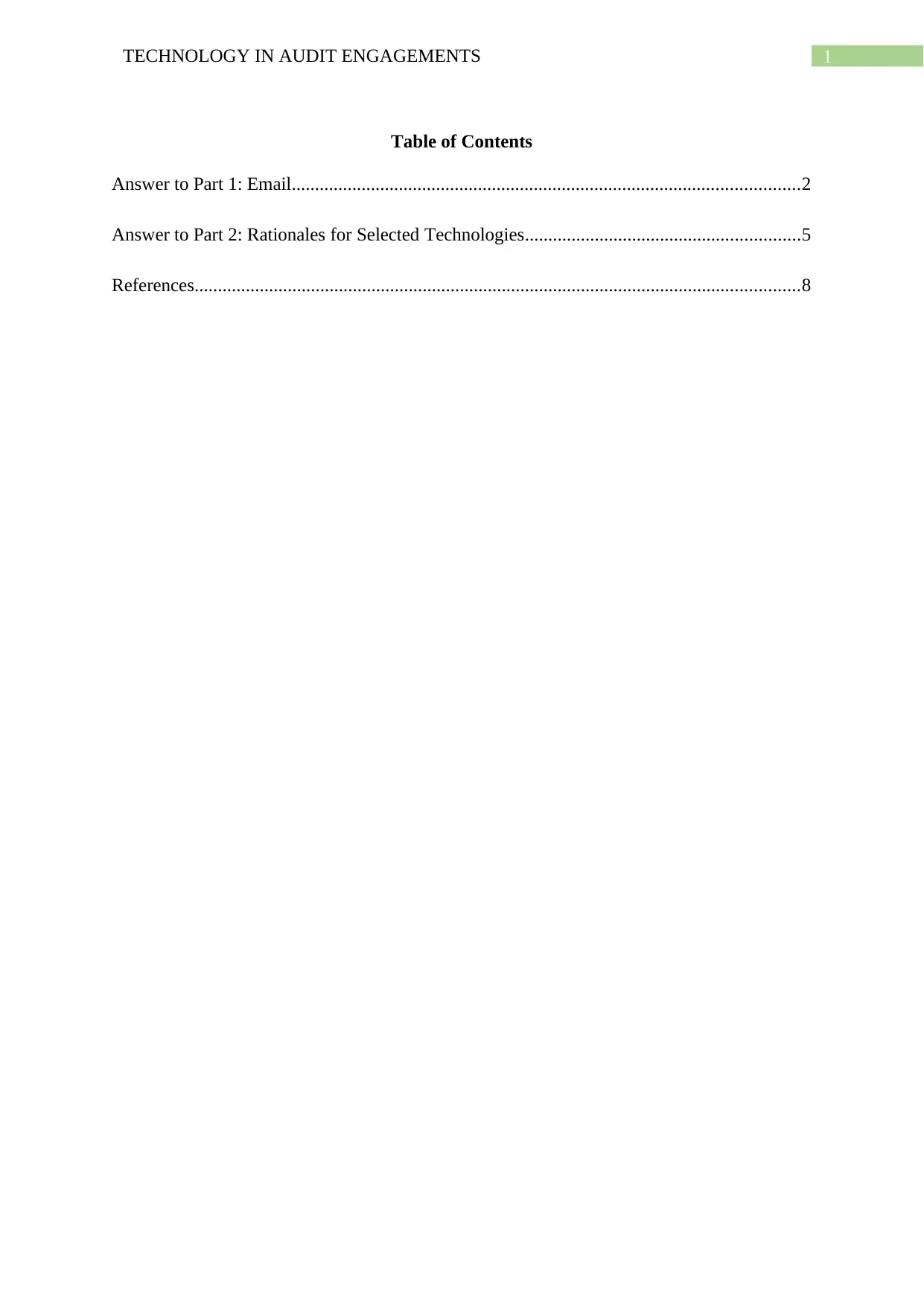
1TECHNOLOGY IN AUDIT ENGAGEMENTS
Table of Contents
Answer to Part 1: Email.............................................................................................................2
Answer to Part 2: Rationales for Selected Technologies...........................................................5
References..................................................................................................................................8
Table of Contents
Answer to Part 1: Email.............................................................................................................2
Answer to Part 2: Rationales for Selected Technologies...........................................................5
References..................................................................................................................................8
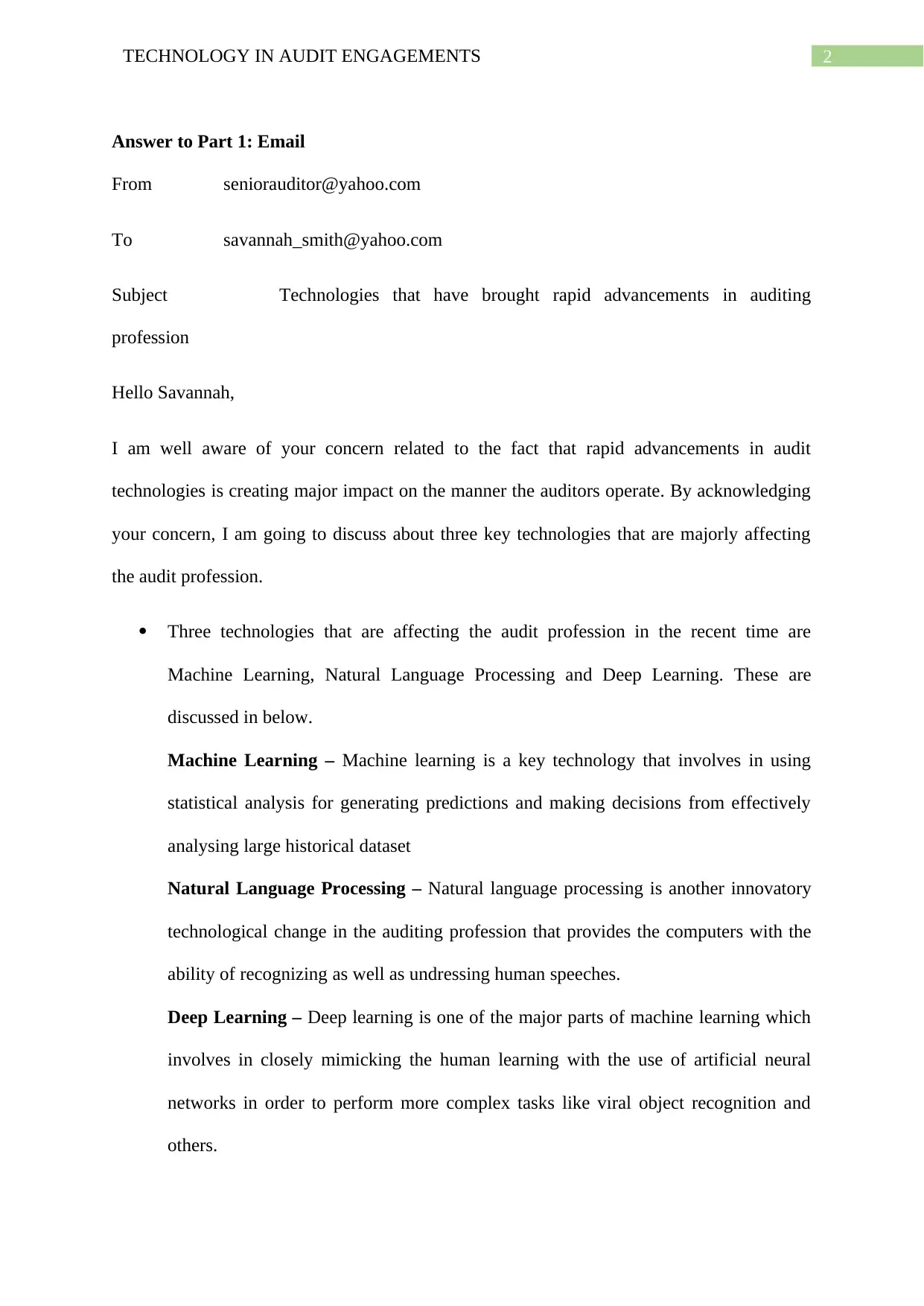
2TECHNOLOGY IN AUDIT ENGAGEMENTS
Answer to Part 1: Email
From seniorauditor@yahoo.com
To savannah_smith@yahoo.com
Subject Technologies that have brought rapid advancements in auditing
profession
Hello Savannah,
I am well aware of your concern related to the fact that rapid advancements in audit
technologies is creating major impact on the manner the auditors operate. By acknowledging
your concern, I am going to discuss about three key technologies that are majorly affecting
the audit profession.
Three technologies that are affecting the audit profession in the recent time are
Machine Learning, Natural Language Processing and Deep Learning. These are
discussed in below.
Machine Learning – Machine learning is a key technology that involves in using
statistical analysis for generating predictions and making decisions from effectively
analysing large historical dataset
Natural Language Processing – Natural language processing is another innovatory
technological change in the auditing profession that provides the computers with the
ability of recognizing as well as undressing human speeches.
Deep Learning – Deep learning is one of the major parts of machine learning which
involves in closely mimicking the human learning with the use of artificial neural
networks in order to perform more complex tasks like viral object recognition and
others.
Answer to Part 1: Email
From seniorauditor@yahoo.com
To savannah_smith@yahoo.com
Subject Technologies that have brought rapid advancements in auditing
profession
Hello Savannah,
I am well aware of your concern related to the fact that rapid advancements in audit
technologies is creating major impact on the manner the auditors operate. By acknowledging
your concern, I am going to discuss about three key technologies that are majorly affecting
the audit profession.
Three technologies that are affecting the audit profession in the recent time are
Machine Learning, Natural Language Processing and Deep Learning. These are
discussed in below.
Machine Learning – Machine learning is a key technology that involves in using
statistical analysis for generating predictions and making decisions from effectively
analysing large historical dataset
Natural Language Processing – Natural language processing is another innovatory
technological change in the auditing profession that provides the computers with the
ability of recognizing as well as undressing human speeches.
Deep Learning – Deep learning is one of the major parts of machine learning which
involves in closely mimicking the human learning with the use of artificial neural
networks in order to perform more complex tasks like viral object recognition and
others.
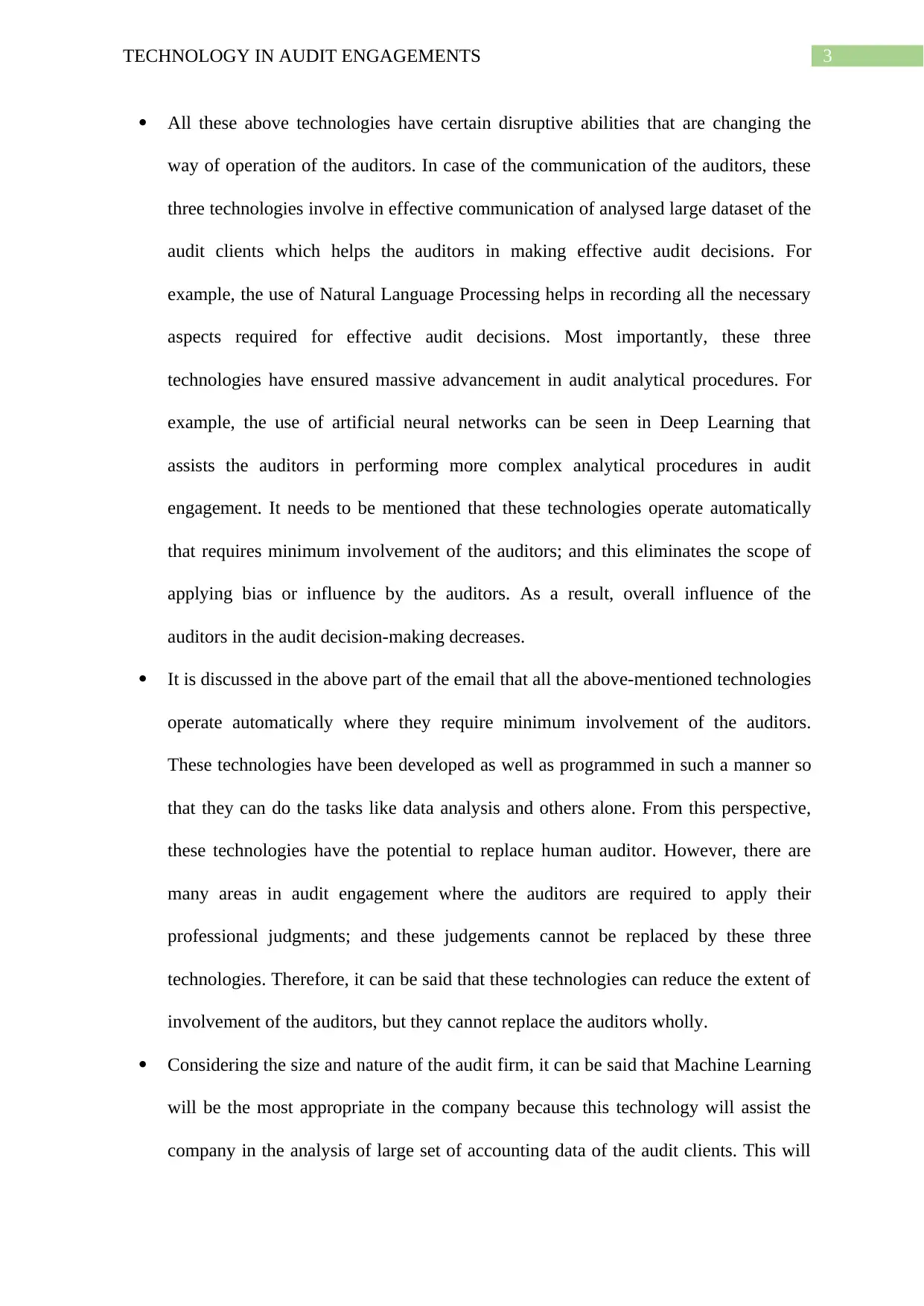
3TECHNOLOGY IN AUDIT ENGAGEMENTS
All these above technologies have certain disruptive abilities that are changing the
way of operation of the auditors. In case of the communication of the auditors, these
three technologies involve in effective communication of analysed large dataset of the
audit clients which helps the auditors in making effective audit decisions. For
example, the use of Natural Language Processing helps in recording all the necessary
aspects required for effective audit decisions. Most importantly, these three
technologies have ensured massive advancement in audit analytical procedures. For
example, the use of artificial neural networks can be seen in Deep Learning that
assists the auditors in performing more complex analytical procedures in audit
engagement. It needs to be mentioned that these technologies operate automatically
that requires minimum involvement of the auditors; and this eliminates the scope of
applying bias or influence by the auditors. As a result, overall influence of the
auditors in the audit decision-making decreases.
It is discussed in the above part of the email that all the above-mentioned technologies
operate automatically where they require minimum involvement of the auditors.
These technologies have been developed as well as programmed in such a manner so
that they can do the tasks like data analysis and others alone. From this perspective,
these technologies have the potential to replace human auditor. However, there are
many areas in audit engagement where the auditors are required to apply their
professional judgments; and these judgements cannot be replaced by these three
technologies. Therefore, it can be said that these technologies can reduce the extent of
involvement of the auditors, but they cannot replace the auditors wholly.
Considering the size and nature of the audit firm, it can be said that Machine Learning
will be the most appropriate in the company because this technology will assist the
company in the analysis of large set of accounting data of the audit clients. This will
All these above technologies have certain disruptive abilities that are changing the
way of operation of the auditors. In case of the communication of the auditors, these
three technologies involve in effective communication of analysed large dataset of the
audit clients which helps the auditors in making effective audit decisions. For
example, the use of Natural Language Processing helps in recording all the necessary
aspects required for effective audit decisions. Most importantly, these three
technologies have ensured massive advancement in audit analytical procedures. For
example, the use of artificial neural networks can be seen in Deep Learning that
assists the auditors in performing more complex analytical procedures in audit
engagement. It needs to be mentioned that these technologies operate automatically
that requires minimum involvement of the auditors; and this eliminates the scope of
applying bias or influence by the auditors. As a result, overall influence of the
auditors in the audit decision-making decreases.
It is discussed in the above part of the email that all the above-mentioned technologies
operate automatically where they require minimum involvement of the auditors.
These technologies have been developed as well as programmed in such a manner so
that they can do the tasks like data analysis and others alone. From this perspective,
these technologies have the potential to replace human auditor. However, there are
many areas in audit engagement where the auditors are required to apply their
professional judgments; and these judgements cannot be replaced by these three
technologies. Therefore, it can be said that these technologies can reduce the extent of
involvement of the auditors, but they cannot replace the auditors wholly.
Considering the size and nature of the audit firm, it can be said that Machine Learning
will be the most appropriate in the company because this technology will assist the
company in the analysis of large set of accounting data of the audit clients. This will
Secure Best Marks with AI Grader
Need help grading? Try our AI Grader for instant feedback on your assignments.
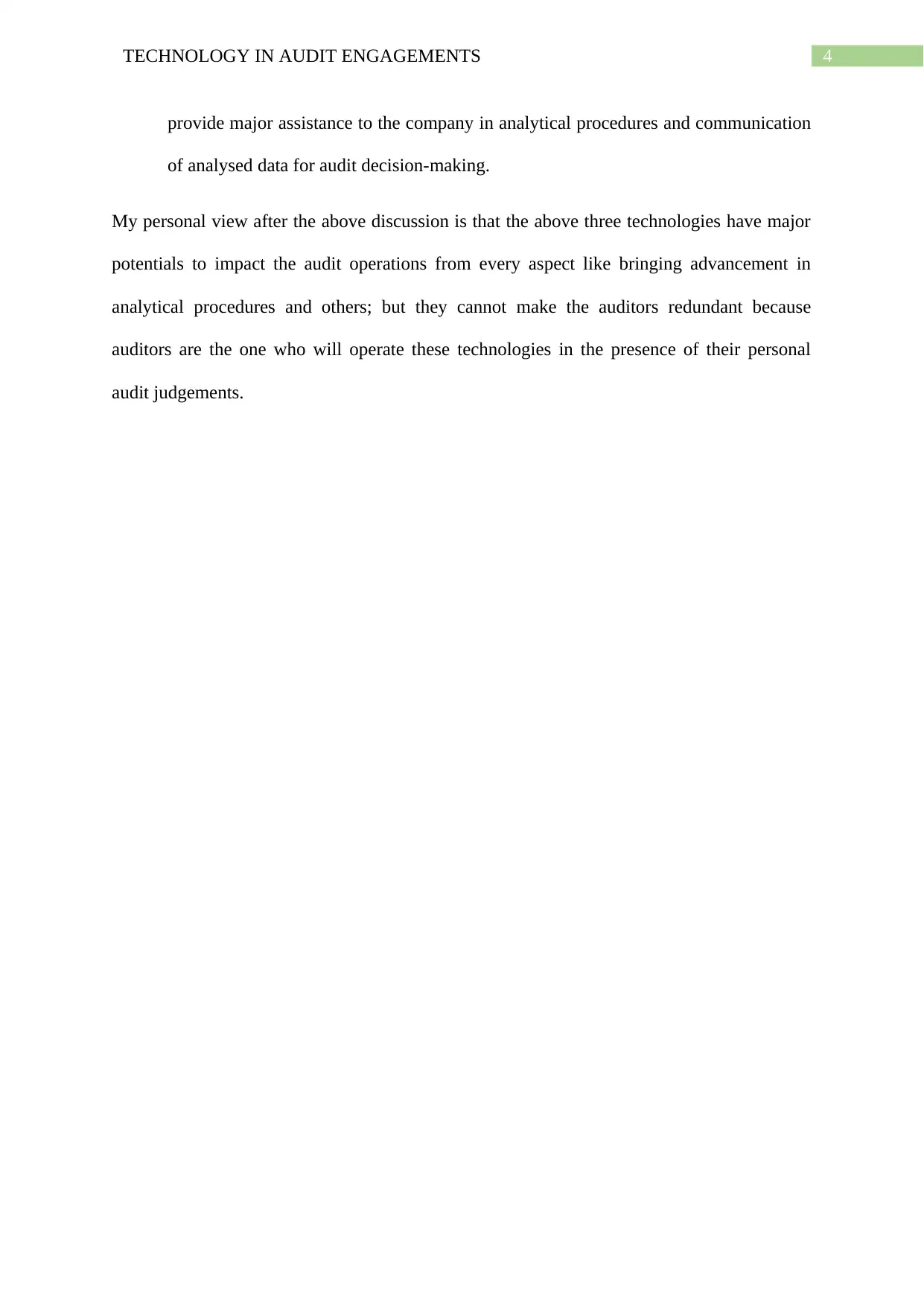
4TECHNOLOGY IN AUDIT ENGAGEMENTS
provide major assistance to the company in analytical procedures and communication
of analysed data for audit decision-making.
My personal view after the above discussion is that the above three technologies have major
potentials to impact the audit operations from every aspect like bringing advancement in
analytical procedures and others; but they cannot make the auditors redundant because
auditors are the one who will operate these technologies in the presence of their personal
audit judgements.
provide major assistance to the company in analytical procedures and communication
of analysed data for audit decision-making.
My personal view after the above discussion is that the above three technologies have major
potentials to impact the audit operations from every aspect like bringing advancement in
analytical procedures and others; but they cannot make the auditors redundant because
auditors are the one who will operate these technologies in the presence of their personal
audit judgements.
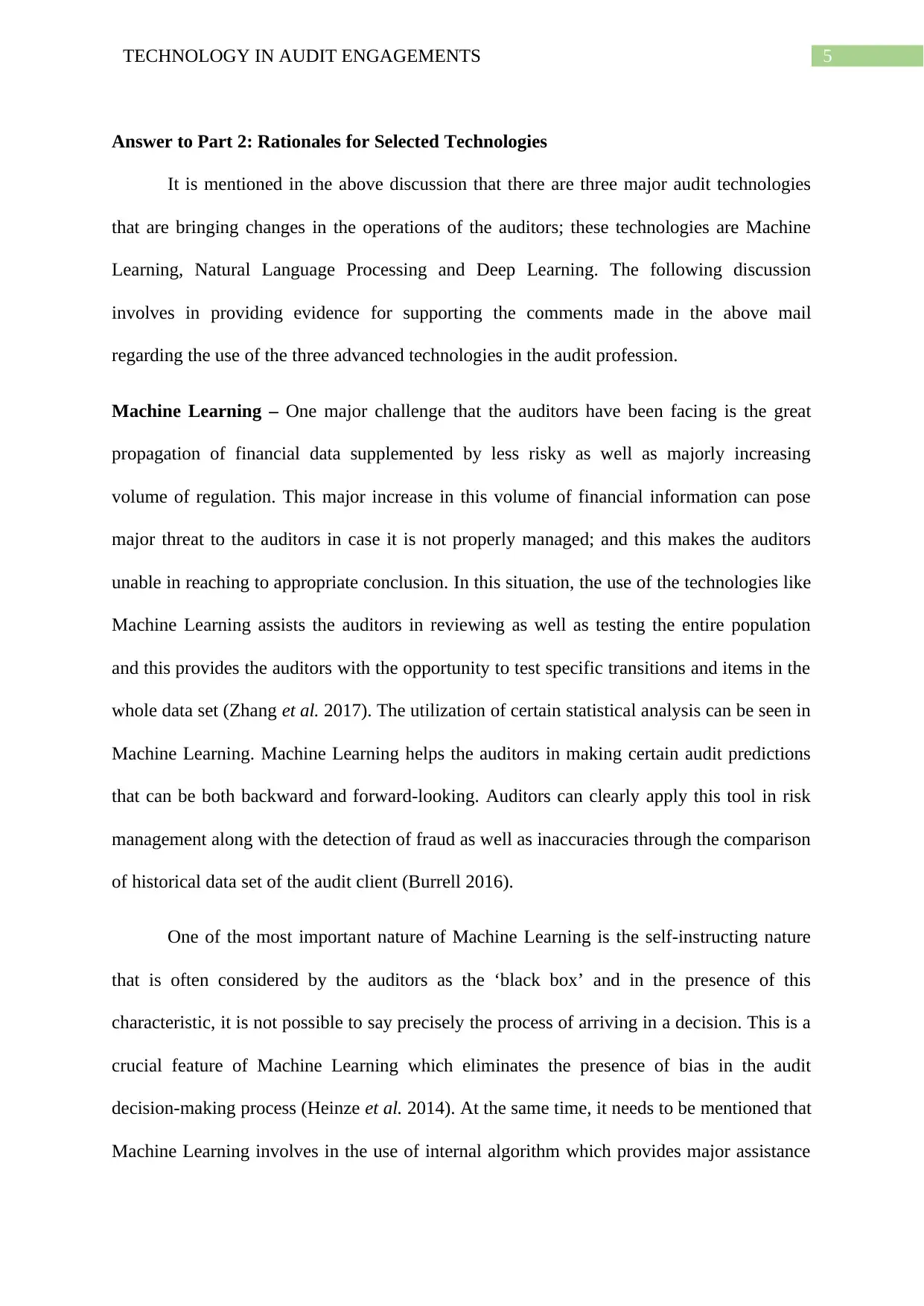
5TECHNOLOGY IN AUDIT ENGAGEMENTS
Answer to Part 2: Rationales for Selected Technologies
It is mentioned in the above discussion that there are three major audit technologies
that are bringing changes in the operations of the auditors; these technologies are Machine
Learning, Natural Language Processing and Deep Learning. The following discussion
involves in providing evidence for supporting the comments made in the above mail
regarding the use of the three advanced technologies in the audit profession.
Machine Learning – One major challenge that the auditors have been facing is the great
propagation of financial data supplemented by less risky as well as majorly increasing
volume of regulation. This major increase in this volume of financial information can pose
major threat to the auditors in case it is not properly managed; and this makes the auditors
unable in reaching to appropriate conclusion. In this situation, the use of the technologies like
Machine Learning assists the auditors in reviewing as well as testing the entire population
and this provides the auditors with the opportunity to test specific transitions and items in the
whole data set (Zhang et al. 2017). The utilization of certain statistical analysis can be seen in
Machine Learning. Machine Learning helps the auditors in making certain audit predictions
that can be both backward and forward-looking. Auditors can clearly apply this tool in risk
management along with the detection of fraud as well as inaccuracies through the comparison
of historical data set of the audit client (Burrell 2016).
One of the most important nature of Machine Learning is the self-instructing nature
that is often considered by the auditors as the ‘black box’ and in the presence of this
characteristic, it is not possible to say precisely the process of arriving in a decision. This is a
crucial feature of Machine Learning which eliminates the presence of bias in the audit
decision-making process (Heinze et al. 2014). At the same time, it needs to be mentioned that
Machine Learning involves in the use of internal algorithm which provides major assistance
Answer to Part 2: Rationales for Selected Technologies
It is mentioned in the above discussion that there are three major audit technologies
that are bringing changes in the operations of the auditors; these technologies are Machine
Learning, Natural Language Processing and Deep Learning. The following discussion
involves in providing evidence for supporting the comments made in the above mail
regarding the use of the three advanced technologies in the audit profession.
Machine Learning – One major challenge that the auditors have been facing is the great
propagation of financial data supplemented by less risky as well as majorly increasing
volume of regulation. This major increase in this volume of financial information can pose
major threat to the auditors in case it is not properly managed; and this makes the auditors
unable in reaching to appropriate conclusion. In this situation, the use of the technologies like
Machine Learning assists the auditors in reviewing as well as testing the entire population
and this provides the auditors with the opportunity to test specific transitions and items in the
whole data set (Zhang et al. 2017). The utilization of certain statistical analysis can be seen in
Machine Learning. Machine Learning helps the auditors in making certain audit predictions
that can be both backward and forward-looking. Auditors can clearly apply this tool in risk
management along with the detection of fraud as well as inaccuracies through the comparison
of historical data set of the audit client (Burrell 2016).
One of the most important nature of Machine Learning is the self-instructing nature
that is often considered by the auditors as the ‘black box’ and in the presence of this
characteristic, it is not possible to say precisely the process of arriving in a decision. This is a
crucial feature of Machine Learning which eliminates the presence of bias in the audit
decision-making process (Heinze et al. 2014). At the same time, it needs to be mentioned that
Machine Learning involves in the use of internal algorithm which provides major assistance
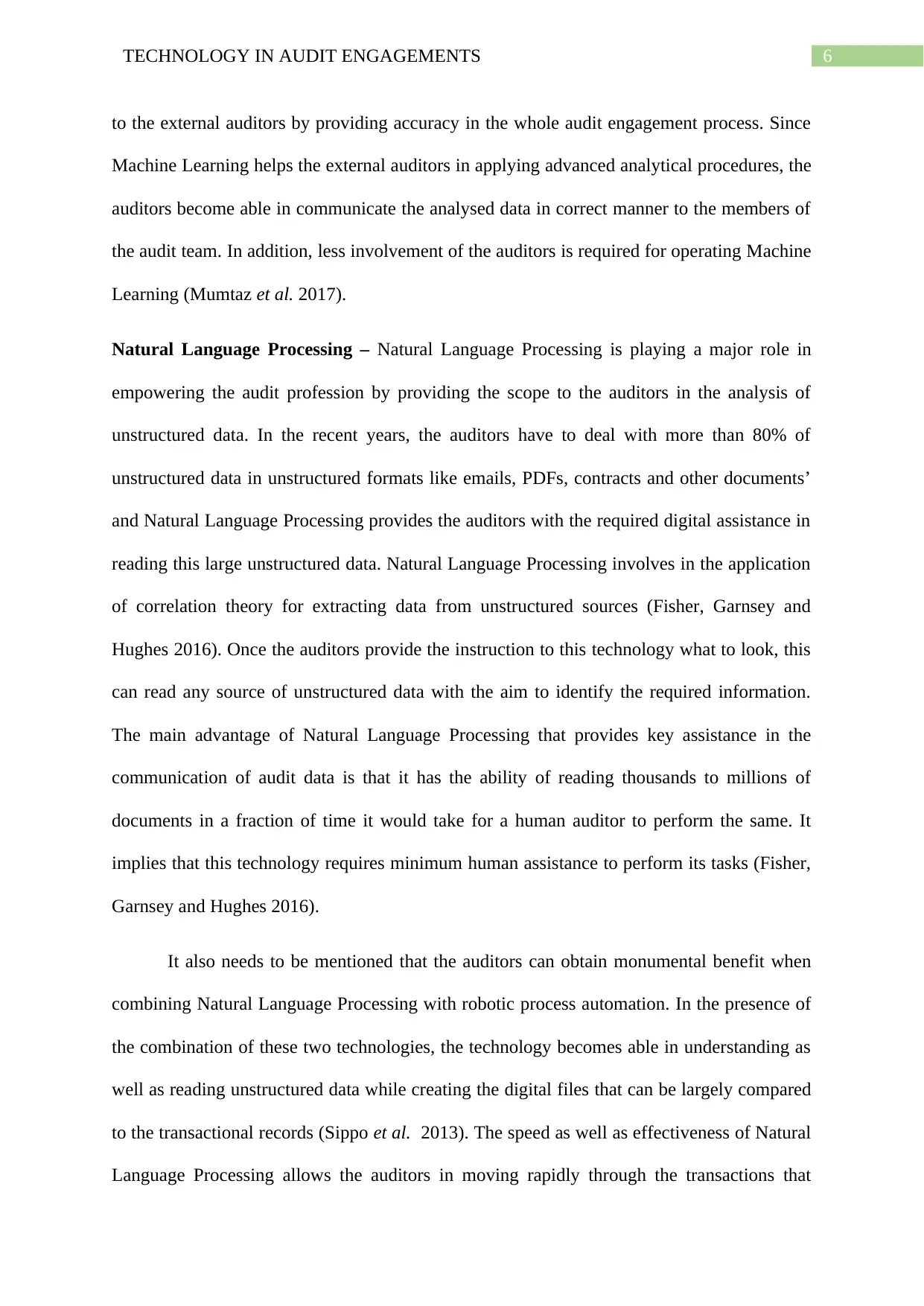
6TECHNOLOGY IN AUDIT ENGAGEMENTS
to the external auditors by providing accuracy in the whole audit engagement process. Since
Machine Learning helps the external auditors in applying advanced analytical procedures, the
auditors become able in communicate the analysed data in correct manner to the members of
the audit team. In addition, less involvement of the auditors is required for operating Machine
Learning (Mumtaz et al. 2017).
Natural Language Processing – Natural Language Processing is playing a major role in
empowering the audit profession by providing the scope to the auditors in the analysis of
unstructured data. In the recent years, the auditors have to deal with more than 80% of
unstructured data in unstructured formats like emails, PDFs, contracts and other documents’
and Natural Language Processing provides the auditors with the required digital assistance in
reading this large unstructured data. Natural Language Processing involves in the application
of correlation theory for extracting data from unstructured sources (Fisher, Garnsey and
Hughes 2016). Once the auditors provide the instruction to this technology what to look, this
can read any source of unstructured data with the aim to identify the required information.
The main advantage of Natural Language Processing that provides key assistance in the
communication of audit data is that it has the ability of reading thousands to millions of
documents in a fraction of time it would take for a human auditor to perform the same. It
implies that this technology requires minimum human assistance to perform its tasks (Fisher,
Garnsey and Hughes 2016).
It also needs to be mentioned that the auditors can obtain monumental benefit when
combining Natural Language Processing with robotic process automation. In the presence of
the combination of these two technologies, the technology becomes able in understanding as
well as reading unstructured data while creating the digital files that can be largely compared
to the transactional records (Sippo et al. 2013). The speed as well as effectiveness of Natural
Language Processing allows the auditors in moving rapidly through the transactions that
to the external auditors by providing accuracy in the whole audit engagement process. Since
Machine Learning helps the external auditors in applying advanced analytical procedures, the
auditors become able in communicate the analysed data in correct manner to the members of
the audit team. In addition, less involvement of the auditors is required for operating Machine
Learning (Mumtaz et al. 2017).
Natural Language Processing – Natural Language Processing is playing a major role in
empowering the audit profession by providing the scope to the auditors in the analysis of
unstructured data. In the recent years, the auditors have to deal with more than 80% of
unstructured data in unstructured formats like emails, PDFs, contracts and other documents’
and Natural Language Processing provides the auditors with the required digital assistance in
reading this large unstructured data. Natural Language Processing involves in the application
of correlation theory for extracting data from unstructured sources (Fisher, Garnsey and
Hughes 2016). Once the auditors provide the instruction to this technology what to look, this
can read any source of unstructured data with the aim to identify the required information.
The main advantage of Natural Language Processing that provides key assistance in the
communication of audit data is that it has the ability of reading thousands to millions of
documents in a fraction of time it would take for a human auditor to perform the same. It
implies that this technology requires minimum human assistance to perform its tasks (Fisher,
Garnsey and Hughes 2016).
It also needs to be mentioned that the auditors can obtain monumental benefit when
combining Natural Language Processing with robotic process automation. In the presence of
the combination of these two technologies, the technology becomes able in understanding as
well as reading unstructured data while creating the digital files that can be largely compared
to the transactional records (Sippo et al. 2013). The speed as well as effectiveness of Natural
Language Processing allows the auditors in moving rapidly through the transactions that
Paraphrase This Document
Need a fresh take? Get an instant paraphrase of this document with our AI Paraphraser
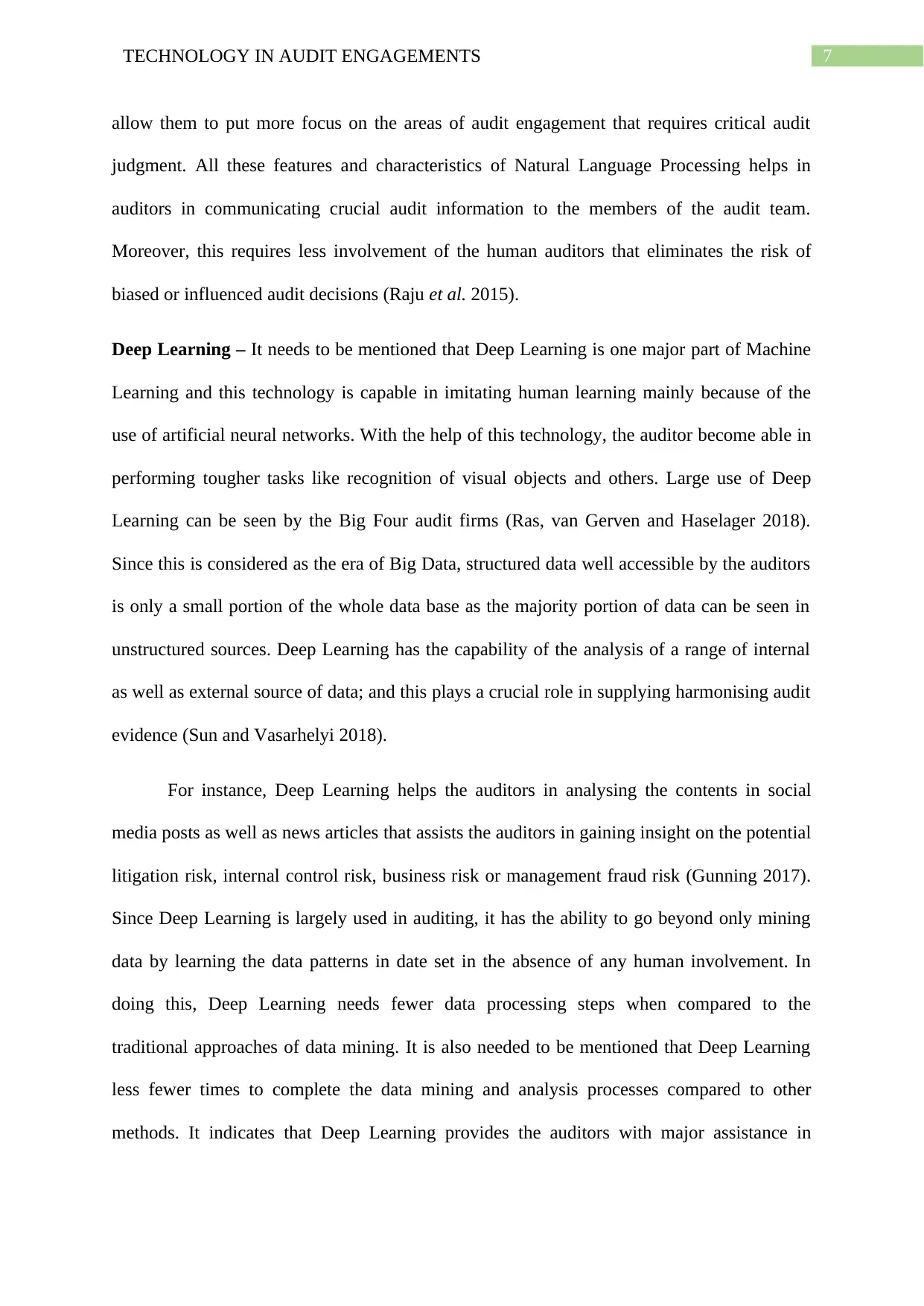
7TECHNOLOGY IN AUDIT ENGAGEMENTS
allow them to put more focus on the areas of audit engagement that requires critical audit
judgment. All these features and characteristics of Natural Language Processing helps in
auditors in communicating crucial audit information to the members of the audit team.
Moreover, this requires less involvement of the human auditors that eliminates the risk of
biased or influenced audit decisions (Raju et al. 2015).
Deep Learning – It needs to be mentioned that Deep Learning is one major part of Machine
Learning and this technology is capable in imitating human learning mainly because of the
use of artificial neural networks. With the help of this technology, the auditor become able in
performing tougher tasks like recognition of visual objects and others. Large use of Deep
Learning can be seen by the Big Four audit firms (Ras, van Gerven and Haselager 2018).
Since this is considered as the era of Big Data, structured data well accessible by the auditors
is only a small portion of the whole data base as the majority portion of data can be seen in
unstructured sources. Deep Learning has the capability of the analysis of a range of internal
as well as external source of data; and this plays a crucial role in supplying harmonising audit
evidence (Sun and Vasarhelyi 2018).
For instance, Deep Learning helps the auditors in analysing the contents in social
media posts as well as news articles that assists the auditors in gaining insight on the potential
litigation risk, internal control risk, business risk or management fraud risk (Gunning 2017).
Since Deep Learning is largely used in auditing, it has the ability to go beyond only mining
data by learning the data patterns in date set in the absence of any human involvement. In
doing this, Deep Learning needs fewer data processing steps when compared to the
traditional approaches of data mining. It is also needed to be mentioned that Deep Learning
less fewer times to complete the data mining and analysis processes compared to other
methods. It indicates that Deep Learning provides the auditors with major assistance in
allow them to put more focus on the areas of audit engagement that requires critical audit
judgment. All these features and characteristics of Natural Language Processing helps in
auditors in communicating crucial audit information to the members of the audit team.
Moreover, this requires less involvement of the human auditors that eliminates the risk of
biased or influenced audit decisions (Raju et al. 2015).
Deep Learning – It needs to be mentioned that Deep Learning is one major part of Machine
Learning and this technology is capable in imitating human learning mainly because of the
use of artificial neural networks. With the help of this technology, the auditor become able in
performing tougher tasks like recognition of visual objects and others. Large use of Deep
Learning can be seen by the Big Four audit firms (Ras, van Gerven and Haselager 2018).
Since this is considered as the era of Big Data, structured data well accessible by the auditors
is only a small portion of the whole data base as the majority portion of data can be seen in
unstructured sources. Deep Learning has the capability of the analysis of a range of internal
as well as external source of data; and this plays a crucial role in supplying harmonising audit
evidence (Sun and Vasarhelyi 2018).
For instance, Deep Learning helps the auditors in analysing the contents in social
media posts as well as news articles that assists the auditors in gaining insight on the potential
litigation risk, internal control risk, business risk or management fraud risk (Gunning 2017).
Since Deep Learning is largely used in auditing, it has the ability to go beyond only mining
data by learning the data patterns in date set in the absence of any human involvement. In
doing this, Deep Learning needs fewer data processing steps when compared to the
traditional approaches of data mining. It is also needed to be mentioned that Deep Learning
less fewer times to complete the data mining and analysis processes compared to other
methods. It indicates that Deep Learning provides the auditors with major assistance in
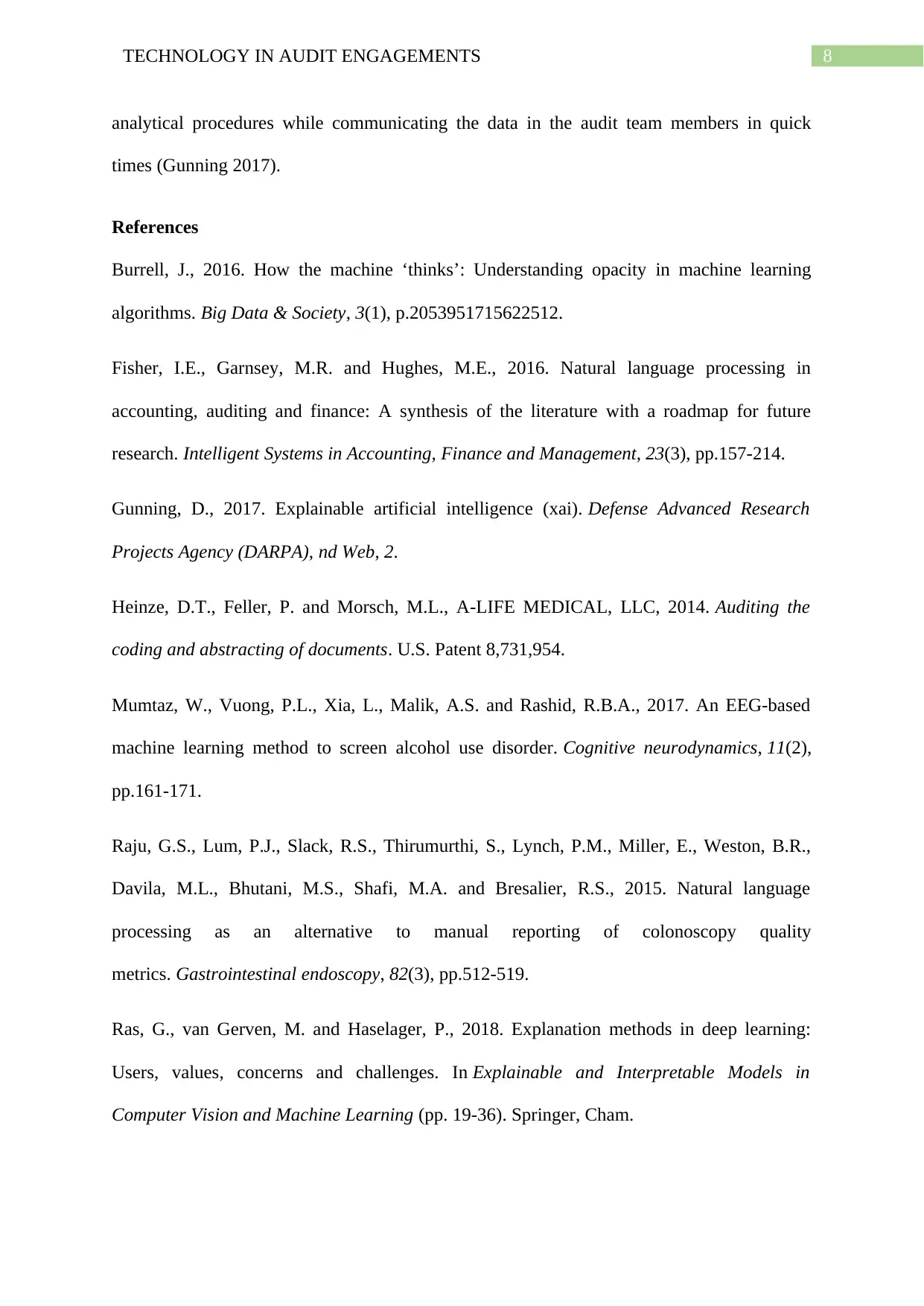
8TECHNOLOGY IN AUDIT ENGAGEMENTS
analytical procedures while communicating the data in the audit team members in quick
times (Gunning 2017).
References
Burrell, J., 2016. How the machine ‘thinks’: Understanding opacity in machine learning
algorithms. Big Data & Society, 3(1), p.2053951715622512.
Fisher, I.E., Garnsey, M.R. and Hughes, M.E., 2016. Natural language processing in
accounting, auditing and finance: A synthesis of the literature with a roadmap for future
research. Intelligent Systems in Accounting, Finance and Management, 23(3), pp.157-214.
Gunning, D., 2017. Explainable artificial intelligence (xai). Defense Advanced Research
Projects Agency (DARPA), nd Web, 2.
Heinze, D.T., Feller, P. and Morsch, M.L., A-LIFE MEDICAL, LLC, 2014. Auditing the
coding and abstracting of documents. U.S. Patent 8,731,954.
Mumtaz, W., Vuong, P.L., Xia, L., Malik, A.S. and Rashid, R.B.A., 2017. An EEG-based
machine learning method to screen alcohol use disorder. Cognitive neurodynamics, 11(2),
pp.161-171.
Raju, G.S., Lum, P.J., Slack, R.S., Thirumurthi, S., Lynch, P.M., Miller, E., Weston, B.R.,
Davila, M.L., Bhutani, M.S., Shafi, M.A. and Bresalier, R.S., 2015. Natural language
processing as an alternative to manual reporting of colonoscopy quality
metrics. Gastrointestinal endoscopy, 82(3), pp.512-519.
Ras, G., van Gerven, M. and Haselager, P., 2018. Explanation methods in deep learning:
Users, values, concerns and challenges. In Explainable and Interpretable Models in
Computer Vision and Machine Learning (pp. 19-36). Springer, Cham.
analytical procedures while communicating the data in the audit team members in quick
times (Gunning 2017).
References
Burrell, J., 2016. How the machine ‘thinks’: Understanding opacity in machine learning
algorithms. Big Data & Society, 3(1), p.2053951715622512.
Fisher, I.E., Garnsey, M.R. and Hughes, M.E., 2016. Natural language processing in
accounting, auditing and finance: A synthesis of the literature with a roadmap for future
research. Intelligent Systems in Accounting, Finance and Management, 23(3), pp.157-214.
Gunning, D., 2017. Explainable artificial intelligence (xai). Defense Advanced Research
Projects Agency (DARPA), nd Web, 2.
Heinze, D.T., Feller, P. and Morsch, M.L., A-LIFE MEDICAL, LLC, 2014. Auditing the
coding and abstracting of documents. U.S. Patent 8,731,954.
Mumtaz, W., Vuong, P.L., Xia, L., Malik, A.S. and Rashid, R.B.A., 2017. An EEG-based
machine learning method to screen alcohol use disorder. Cognitive neurodynamics, 11(2),
pp.161-171.
Raju, G.S., Lum, P.J., Slack, R.S., Thirumurthi, S., Lynch, P.M., Miller, E., Weston, B.R.,
Davila, M.L., Bhutani, M.S., Shafi, M.A. and Bresalier, R.S., 2015. Natural language
processing as an alternative to manual reporting of colonoscopy quality
metrics. Gastrointestinal endoscopy, 82(3), pp.512-519.
Ras, G., van Gerven, M. and Haselager, P., 2018. Explanation methods in deep learning:
Users, values, concerns and challenges. In Explainable and Interpretable Models in
Computer Vision and Machine Learning (pp. 19-36). Springer, Cham.
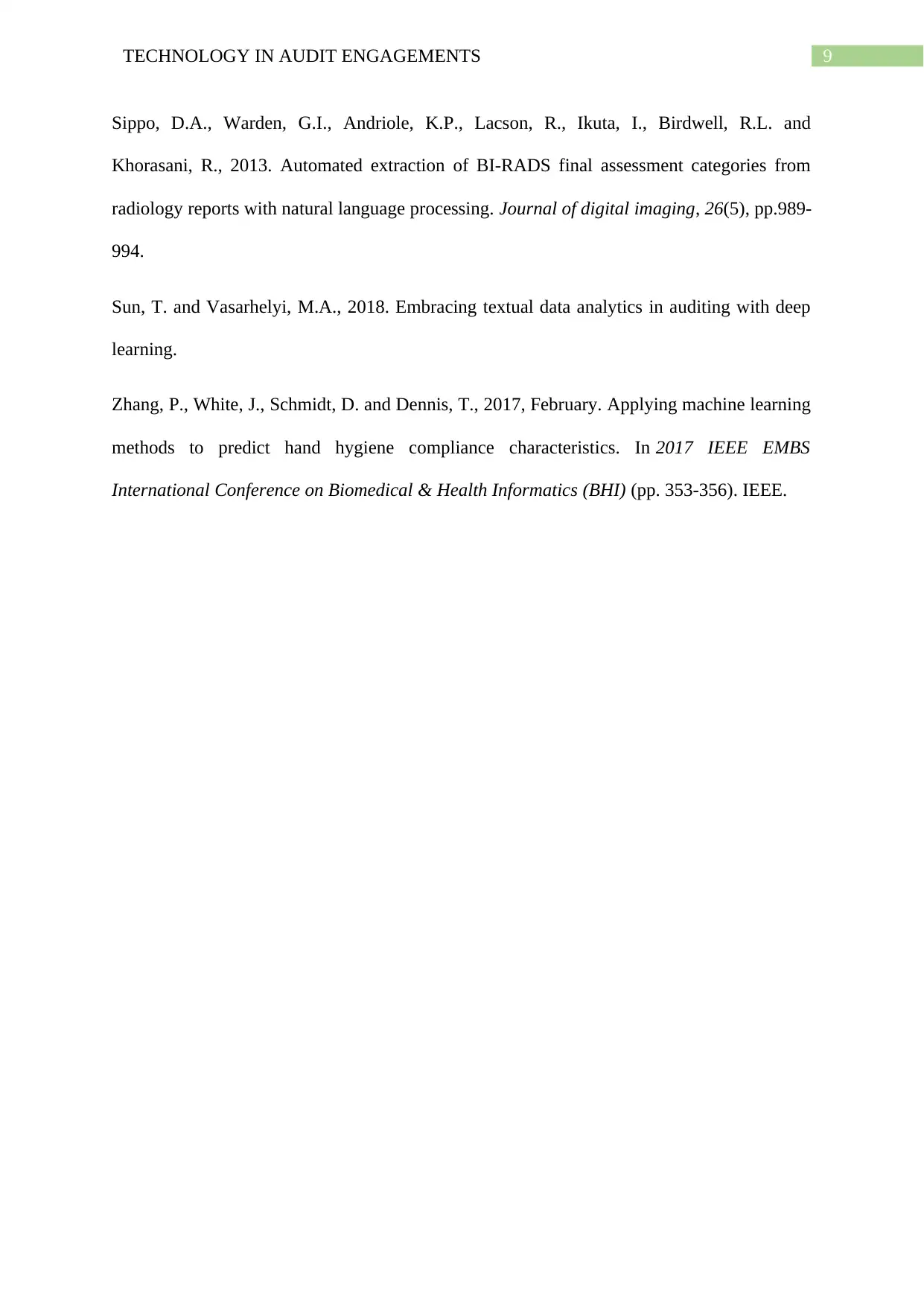
9TECHNOLOGY IN AUDIT ENGAGEMENTS
Sippo, D.A., Warden, G.I., Andriole, K.P., Lacson, R., Ikuta, I., Birdwell, R.L. and
Khorasani, R., 2013. Automated extraction of BI-RADS final assessment categories from
radiology reports with natural language processing. Journal of digital imaging, 26(5), pp.989-
994.
Sun, T. and Vasarhelyi, M.A., 2018. Embracing textual data analytics in auditing with deep
learning.
Zhang, P., White, J., Schmidt, D. and Dennis, T., 2017, February. Applying machine learning
methods to predict hand hygiene compliance characteristics. In 2017 IEEE EMBS
International Conference on Biomedical & Health Informatics (BHI) (pp. 353-356). IEEE.
Sippo, D.A., Warden, G.I., Andriole, K.P., Lacson, R., Ikuta, I., Birdwell, R.L. and
Khorasani, R., 2013. Automated extraction of BI-RADS final assessment categories from
radiology reports with natural language processing. Journal of digital imaging, 26(5), pp.989-
994.
Sun, T. and Vasarhelyi, M.A., 2018. Embracing textual data analytics in auditing with deep
learning.
Zhang, P., White, J., Schmidt, D. and Dennis, T., 2017, February. Applying machine learning
methods to predict hand hygiene compliance characteristics. In 2017 IEEE EMBS
International Conference on Biomedical & Health Informatics (BHI) (pp. 353-356). IEEE.
1 out of 10
Related Documents
Your All-in-One AI-Powered Toolkit for Academic Success.
+13062052269
info@desklib.com
Available 24*7 on WhatsApp / Email
![[object Object]](/_next/static/media/star-bottom.7253800d.svg)
Unlock your academic potential
© 2024 | Zucol Services PVT LTD | All rights reserved.





